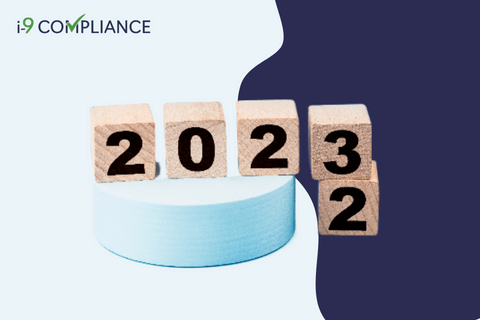Big Changes to I-9 Compliance for 2023

March 16, 2023
Since the start of the COVID-19 pandemic, employers have faced rapid-fire changes to the employment eligibility verification (Form I-9) process. For example, how to stay compliant changed drastically when offices worldwide closed. The end of the pandemic has proven it would require even more adjustments for employers struggling with I-9 compliance.
Despite its crucial role, many overlook Form I-9’s importance in hiring. For example, this process involves verifying the identity and work authorization of all new hires. Unfortunately, this negligence has led to many employers facing costly government inspections and penalties.
This year, many expect Form I-9 to undergo significant changes. Such changes could include more stringent requirements and substantial penalties. As such, employers should find it crucial to stay updated about the changes to maintain compliance. Here are three of the most important new and potential developments employers must know to maintain I-9 compliance.
Potential Remote I-9 Verification Alternatives
In late 2022, the Department of Homeland Security (DHS) published a notice of proposed rulemaking in the Federal Register. This proposal would allow the DHS to create pilot programs for alternative “document examination procedures.” For example, throughout the pandemic, employers whose workplaces operated remotely due to COVID-19 precautions used email, video calls, and fax to verify employees’ identity and employment authorization documentation.
Currently, these same flexibilities will continue through July 2023. According to the DHS, employers should not expect another extension for these temporary flexibilities. However, this proposed rule would allow the Secretary of Health and Human Services (HHS) to continue alternative verification procedures. These options would be pilot programs that offer a suitable level of security from fraud and abuse. These programs could provide significant benefits for many employers with remote workers, potentially impacting the verification process as a whole.
New Version of the Form I-9
Though the current Form I-9 expired on October 31, 2022, the DHS announced a new and revised version. However, the DHS instructed employers to continue using the expired Form I-9. This request will remain until the publishing of the new Form I-9 in the Federal Register.
It is worth taking note of some of the proposed changes. For example:
- A single-page format would include Sections 1 and 2,
- Section 3 has moved to a supplement for optional use as needed,
- The list of instructions as shortened, and some stringent technical requirements have seen reductions; for example, printing N/A in unused blanks,
- The electronic Form I-9 has seen updates removing aspects that limited the devices capable of viewing and completing Form I-9.
Employers should remember that these changes remain tentative. As such, the mentioned details could change before the final version releases for their use.
Increased Penalties for Non-compliance
The DHS has increased penalties for violating Form I-9 requirements in the new year. Hiring unauthorized workers has also seen a significant penalty increase. Under the new penalties published in the Federal Register on January 13, penalties for violations in the Form I-9 paperwork include:
- Minimum Fine: $272
- Maximum Fine: $2,701
Penalties for the knowing, recruitment, hiring, retaining, or referral of unauthorized workers include:
1st Offense: $676 to $5,404
2nd Offense: $5,404 to $13,508
3rd Offense: $8,106 to $27,018
These penalty increases could prove significant. For many, the potential losses resulting from an error can prove disastrous.
Conclusion
With these current and potential changes, the potential liability for failures in the I-9 process has never been higher. The best way to keep up with the ever-changing regulations and ensure compliance is to use an electronic I-9 management system. This system can provide step-by-step guidance and a suite of features, including storing completed forms, documentation, and reminders on when to take action to ensure continued compliance.
Learn more about automating your employment eligibility verification and ensuring compliance with I-9 Compliance.